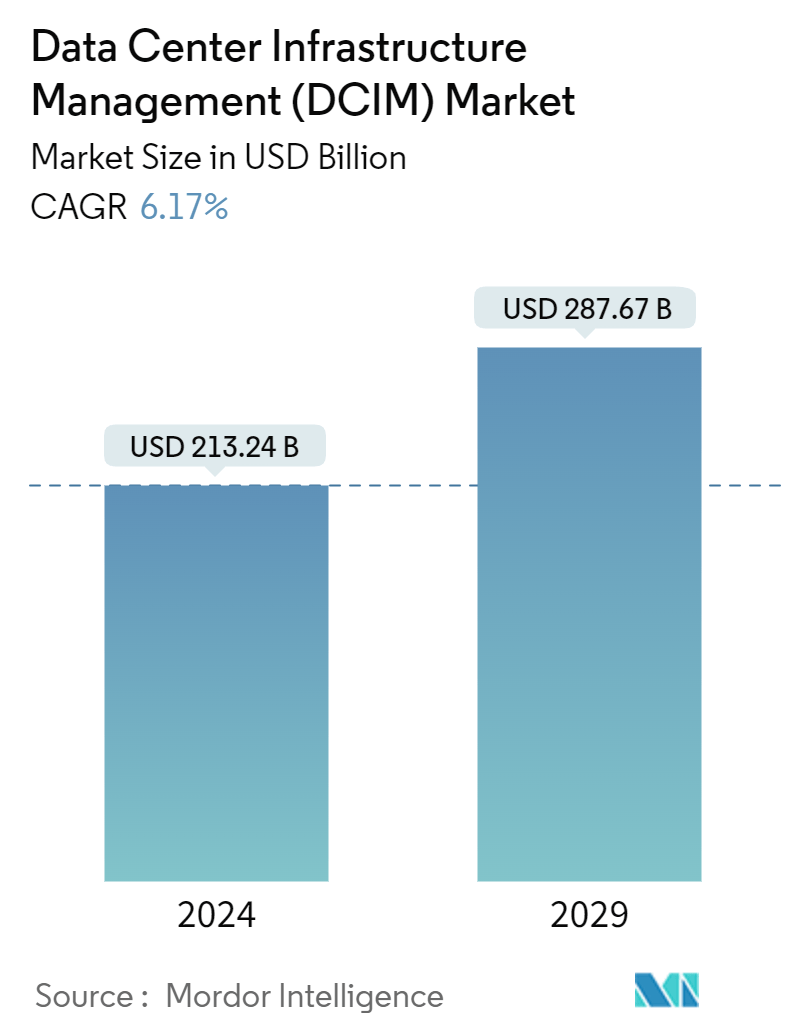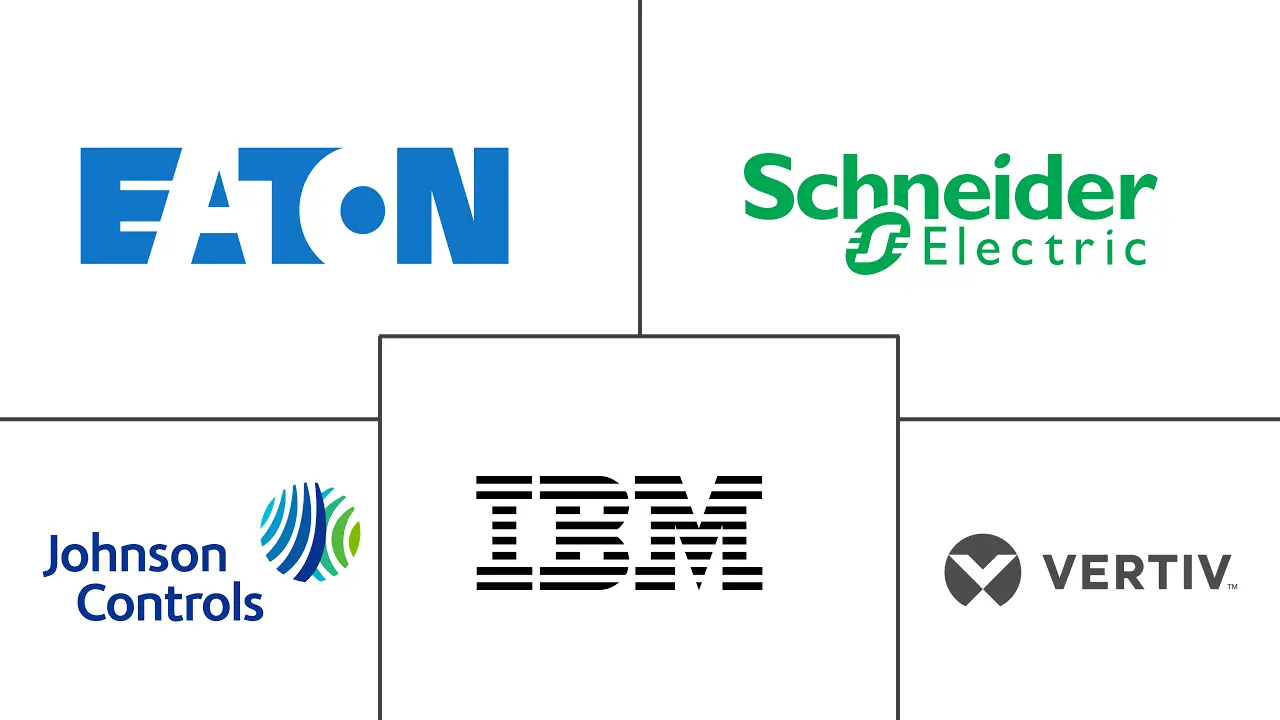Market Size of Data Center Infrastructure Management (DCIM) Industry

| Study Period | 2019 - 2029 |
| Market Size (2024) | USD 213.24 Billion |
| Market Size (2029) | USD 287.67 Billion |
| CAGR (2024 - 2029) | 6.17 % |
| Fastest Growing Market | Asia Pacific |
| Largest Market | North America |
| Market Concentration | Low |
Major Players
*Disclaimer: Major Players sorted in no particular order |
Data Center Infrastructure Management (DCIM) Market Analysis
The Data Center Infrastructure Management Market size is estimated at USD 213.24 billion in 2024, and is expected to reach USD 287.67 billion by 2029, growing at a CAGR of 6.17% during the forecast period (2024-2029).
To effectively monitor, manage, and optimize the infrastructure and resources in a data center facility, data center infrastructure management is an integrated software and hardware solution used by IT managers and operators. DCIM encompasses various tools and technologies that help organizations plan, operate, and maintain their data center environments.
- Due to the rising demand for secure IT infrastructure and reliable, efficient data center operations have become essential. As the importance of cloud computing increases, companies are turning to data centers for their IT infrastructure requirements as they connect to more interconnected devices.
- Automation and optimization make it possible to reduce operating costs, improve the efficiency of operations, and scale up. Automated tools improve the performance and efficiency of data centers and allow organizations to reduce the amount of time and effort needed for IT infrastructure management, while optimization tools enable them to gain insight into their infrastructures so that they can make informed choices.
- The increasing demand for cloud resources and data centers in terms of consumer services and business has led to the development of a large-scale public cloud data center. Factors are expected to influence the development of the DCIM market.
- Moreover, the demand for the maintenance of physical and network infrastructure in data centers is increasing as enterprises across the world move their workloads to cloud services due to data security and easy recovery benefits that come with them.
- In terms of capital expenditure and energy efficiency charges, the establishment of servers in data centers has proven to be advantageous. However, the growth of the market was hampered by the increase in costs. Increasing demand for services, in particular, as a result of the increased number of engineers commutating to achieve better efficiency, data security problems, and difficulties arising from greater dependency on data center facilities are largely responsible for this increase.
- The demand for DCIM solutions is expected to increase in the post-COVID era as businesses rely on digital technologies. The establishment of data centers is expected to increase the demand for DCIM solutions and services, driven by the increasing use of Internet of Things technology, smart device proliferation, and a rise in digital transaction volumes.
Data Center Infrastructure Management (DCIM) Industry Segmentation
Data center infrastructure management (DCIM) is a set of tools and processes used to manage the infrastructure components of a data center environment. It enables IT teams to monitor all components, their configurations, interdependencies, and optimum performance. This is expected to ensure that data center operations are effective and cost-effectively
The data center infrastructure management market is segmented by data center type (small and medium-sized data centers, large data centers, and enterprise data centers), deployment type (on-premise and colocation), end user (IT, BFSI, healthcare, manufacturing, and other end users), and geography (North America, Europe, Asia-Pacific, and Rest of the World).
The market sizes and forecasts are provided in USD for all the above segments.
| By Data Center Type | |
| Small and Medium-sized Data Centers | |
| Large Data Centers | |
| Enterprise Data Centers |
| By Deployment Type | |
| On-premise | |
| Colocation |
| By End User | |
| IT | |
| BFSI | |
| Healthcare | |
| Manufacturing | |
| Other End Users |
| By Geography | |
| North America | |
| Europe | |
| Asia-Pacific | |
| Rest of the World |
Data Center Infrastructure Management (DCIM) Market Size Summary
The Data Center Infrastructure Management (DCIM) market is poised for significant growth over the forecast period, driven by the increasing demand for efficient management of data center operations. The market is experiencing a transformation due to the rise in cloud computing, big data, and artificial intelligence, which necessitate the management of high rack densities and limited space to minimize IT system downtime. The COVID-19 pandemic has posed challenges, causing delays in new data center constructions, but the need for advanced management solutions remains critical. The integration of API capabilities into DCIM solutions and the shift towards software-defined data centers are expected to enhance operational efficiency and scalability. Additionally, the expansion of edge computing and the deployment of smaller data centers closer to population centers are anticipated to further propel market growth.
In North America, the DCIM market is bolstered by the region's mature data center infrastructure and the declining costs of servers, which have accelerated the adoption of cloud computing. The United States, in particular, has seen a surge in data center capacity, with significant investments in edge computing capabilities. Key players in the market, such as IBM, Siemens, and Schneider Electric, are leveraging strategic partnerships and innovations to maintain a competitive edge. These companies are focusing on enhancing connectivity and energy efficiency through advanced technologies and collaborations. The market's competitive landscape is characterized by high rivalry, with major players continuously evolving their offerings to meet the growing demands of data center management.
Data Center Infrastructure Management (DCIM) Market Size - Table of Contents
-
1. MARKET INSIGHTS
-
1.1 Market Overview
-
1.2 Industry Attractiveness - Porter's Five Forces Analysis
-
1.2.1 Bargaining Power of Suppliers
-
1.2.2 Bargaining Power of Consumers
-
1.2.3 Threat of New Entrants
-
1.2.4 Threat of Substitute Products
-
1.2.5 Intensity of Competitive Rivalry
-
-
1.3 Assessment of the Impact of the COVID-19 Pandemic on the Industry
-
-
2. MARKET SEGMENTATION
-
2.1 By Data Center Type
-
2.1.1 Small and Medium-sized Data Centers
-
2.1.2 Large Data Centers
-
2.1.3 Enterprise Data Centers
-
-
2.2 By Deployment Type
-
2.2.1 On-premise
-
2.2.2 Colocation
-
-
2.3 By End User
-
2.3.1 IT
-
2.3.2 BFSI
-
2.3.3 Healthcare
-
2.3.4 Manufacturing
-
2.3.5 Other End Users
-
-
2.4 By Geography
-
2.4.1 North America
-
2.4.2 Europe
-
2.4.3 Asia-Pacific
-
2.4.4 Rest of the World
-
-
Data Center Infrastructure Management (DCIM) Market Size FAQs
How big is the Data Center Infrastructure Management Market?
The Data Center Infrastructure Management Market size is expected to reach USD 213.24 billion in 2024 and grow at a CAGR of 6.17% to reach USD 287.67 billion by 2029.
What is the current Data Center Infrastructure Management Market size?
In 2024, the Data Center Infrastructure Management Market size is expected to reach USD 213.24 billion.

